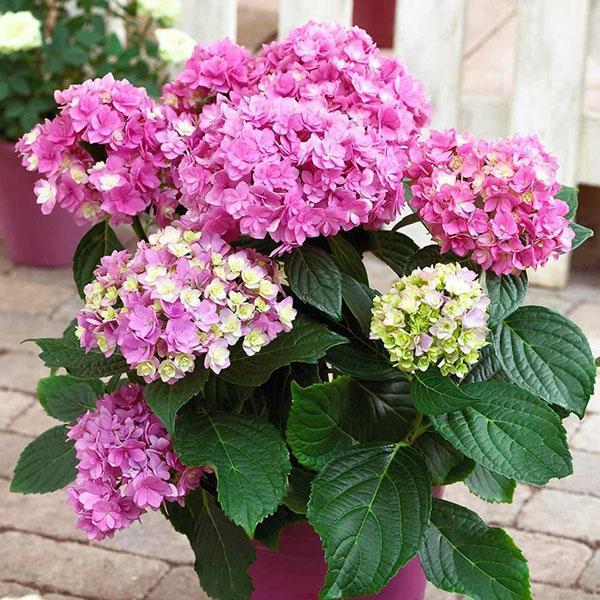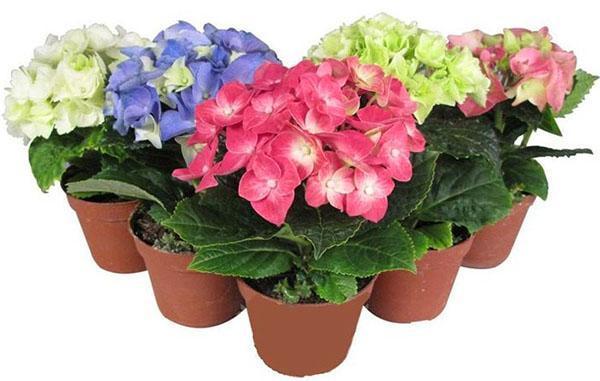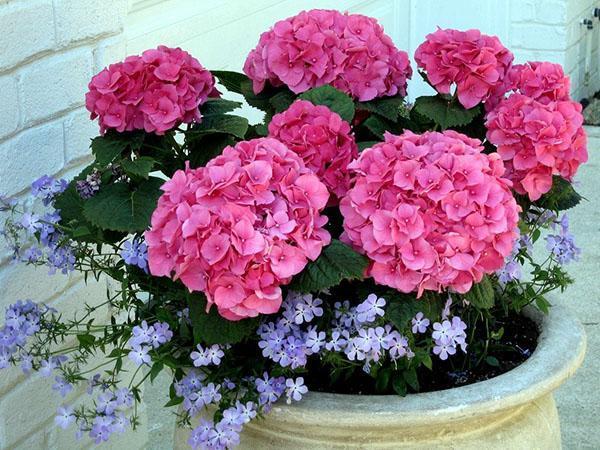A dignified home decoration - indoor hydrangea
 Many lovers of flowering plants try to decorate with them not only summer cottages, but also their homes. Indoor hydrangea is a wonderful option to fill your home with the pleasant aroma of lush flowers. It appeared on the windows of European houses in the 18th century and remains a rather popular plant to this day. Thanks to the many different varieties bred by breeders, the flower never ceases to delight its loyal fans.
Many lovers of flowering plants try to decorate with them not only summer cottages, but also their homes. Indoor hydrangea is a wonderful option to fill your home with the pleasant aroma of lush flowers. It appeared on the windows of European houses in the 18th century and remains a rather popular plant to this day. Thanks to the many different varieties bred by breeders, the flower never ceases to delight its loyal fans.

The secret of the attractiveness of a stately flower
 The common garden hydrangea is a perennial, lushly flowering shrub. Its main feature is inflorescences in the form of caps filled with small buds. Depending on the kind of soil on which indoor hydrangea is grown, it can be of different colors. These colors can be:
The common garden hydrangea is a perennial, lushly flowering shrub. Its main feature is inflorescences in the form of caps filled with small buds. Depending on the kind of soil on which indoor hydrangea is grown, it can be of different colors. These colors can be:
- pinkish;

- lilac;

- snow-white;

- blue;

- gently light green.

If you plant the plant in alkaline soil, the buds will be pink or lilac. In acidic soil, you get a blue tint. For a snow-white color, a neutral soil is suitable. Based on this, it is not at all difficult to find a suitable option for a home interior.
Some people believe that hydrangea is a purely garden plant that is only available in a street flower bed. In fact, for a long time, lovers of stately bouquets have been growing it at home on a windowsill. The only difference is in the size of the buds.  In this photo of a room hydrangea flower, you can see her lush hats in all their splendor.
In this photo of a room hydrangea flower, you can see her lush hats in all their splendor.
It is known that the buds of a houseplant are slightly smaller than its garden cousin. But if you try hard and apply all the rules for caring for a flower, you can achieve good results.
There are many varieties of a wonderful indoor plant - hydrangeas, which are grown on the windowsills of apartments and country houses. The most popular ones are blue, pink and red. These include:
- Ramars Mars;

- Earley Blue;

- Europe;

- Hamburg;

- Goliath;

- Prima;

- Red sensation;

- Souer Tharese;

- Jasmine.

It is interesting that each of the above varieties has its own external characteristics, which are important to consider when leaving.
Basic rules of care
 As practice shows, caring for room hydrangea at home provides several important rules:
As practice shows, caring for room hydrangea at home provides several important rules:
- conditions of detention;
- competent watering;
- regular feeding;
- winter care.
 In order for a flower to successfully develop on a home windowsill, it is necessary to create suitable conditions. An important aspect is lighting... Hortense does not like to be exposed to direct sunlight. Therefore, it is better to place a flower pot away from a window facing south. Otherwise, the light will damage the decorative effect of the leaf plates and disrupt the flowering period. It is important to consider that indoor hydrangea prefers the same type of lighting all year round.In view of this, in winter, it is necessary to turn on fluorescent lamps for the successful development of the plant.
In order for a flower to successfully develop on a home windowsill, it is necessary to create suitable conditions. An important aspect is lighting... Hortense does not like to be exposed to direct sunlight. Therefore, it is better to place a flower pot away from a window facing south. Otherwise, the light will damage the decorative effect of the leaf plates and disrupt the flowering period. It is important to consider that indoor hydrangea prefers the same type of lighting all year round.In view of this, in winter, it is necessary to turn on fluorescent lamps for the successful development of the plant.
To ensure comfortable conditions, the flower is placed 2 or 3 meters from the south window, where there is always direct sunlight.
 In addition, a regular supply of fresh air is important for the plant. Therefore, the room where the flower grows is periodically ventilated. In summer, flowerpots are taken out on balconies, terraces or shady areas of the garden. Despite the fact that the indoor hydrangea is dormant in winter, it still needs care. It includes regular watering of the plant.
In addition, a regular supply of fresh air is important for the plant. Therefore, the room where the flower grows is periodically ventilated. In summer, flowerpots are taken out on balconies, terraces or shady areas of the garden. Despite the fact that the indoor hydrangea is dormant in winter, it still needs care. It includes regular watering of the plant.  If you can see that the earthen clod is drying up, it should be watered.
If you can see that the earthen clod is drying up, it should be watered.
You can store sleeping hydrangeas in winter in a living room or on a balcony. But, do not forget to cover it to protect it from the cold.
Since the stately flower is very fond of moisture, during the period of active growth, it needs a sufficient amount of liquid. In this case, one should adhere to this rule - the root area should always be moist. And the upper part must be dry before watering. As a result, the plant will not rot. For example, indoor hydrangea Jasmine prefers moderate watering. If overflow is observed, there is a chance of root decay. When the soil dries up - loss of buds and foliage. Moisten the plant, preferably with a warm, settled liquid with the addition of a few drops of lemon.
 An important condition for caring for hydrangeas is feeding. It is mainly held in the summer. For this, a solution of mineral fertilizers is prepared, which includes 30 grams of potassium sulfate and ammonium nitrate with the addition of 40 grams of superphosphate. These ingredients are dissolved in 10 liters of water and the plant is watered twice for 7 days. The feeding process continues until mid-August. During this period, the hydrangea stops actively growing, and switches to the formation of flower buds.
An important condition for caring for hydrangeas is feeding. It is mainly held in the summer. For this, a solution of mineral fertilizers is prepared, which includes 30 grams of potassium sulfate and ammonium nitrate with the addition of 40 grams of superphosphate. These ingredients are dissolved in 10 liters of water and the plant is watered twice for 7 days. The feeding process continues until mid-August. During this period, the hydrangea stops actively growing, and switches to the formation of flower buds.
It is during this period that it is necessary to remove weak basal shoots from the plant so that it gains strength.
Reproduction methods of indoor flower
 When a flower gains the attention and love of its fans, it gradually grows in their homes. Reproduction of room hydrangea is carried out in three ways: by seeds, dividing the bush and cuttings.
When a flower gains the attention and love of its fans, it gradually grows in their homes. Reproduction of room hydrangea is carried out in three ways: by seeds, dividing the bush and cuttings.
 To breed hydrangea at home with seeds, at the end of winter, planting material is sown in containers with soil. It is not necessary to cover it with earth, but it is advisable to cover it with cellophane. Crops are moistened and ventilated daily until the first shoots appear. Then the film should be removed. When the seedlings show two strengthened leaves, they are planted in separate pots, where they will fully develop.
To breed hydrangea at home with seeds, at the end of winter, planting material is sown in containers with soil. It is not necessary to cover it with earth, but it is advisable to cover it with cellophane. Crops are moistened and ventilated daily until the first shoots appear. Then the film should be removed. When the seedlings show two strengthened leaves, they are planted in separate pots, where they will fully develop.
 One of the simplest methods of flower propagation is dividing the bush. During the spring transplantation of hydrangeas, the bush is divided into several parts. Each individual process must have sufficient roots and a growth point.
One of the simplest methods of flower propagation is dividing the bush. During the spring transplantation of hydrangeas, the bush is divided into several parts. Each individual process must have sufficient roots and a growth point.
Before planting the bushes in pots, the shoots are shortened a little so that the plant takes root well. With the onset of autumn, the hydrangea will turn into a full-fledged indoor flower.
 Some color lovers propagate hydrangea by cuttings. At the end of January, cuttings with three internodes are cut from the basal stems. Having processed them with a root stimulant, they are planted in a prepared substrate. After a month, the cuttings start up roots, which indicates their readiness for an independent life. Plants are transplanted into separate pots where they will flourish magnificently.
Some color lovers propagate hydrangea by cuttings. At the end of January, cuttings with three internodes are cut from the basal stems. Having processed them with a root stimulant, they are planted in a prepared substrate. After a month, the cuttings start up roots, which indicates their readiness for an independent life. Plants are transplanted into separate pots where they will flourish magnificently.
Caring fans of indoor hydrangea try to adhere to the basic rules of care and cultivation of this plant. Therefore, such a sweet beauty with a magnificent bouquet of flowers lives in their houses.